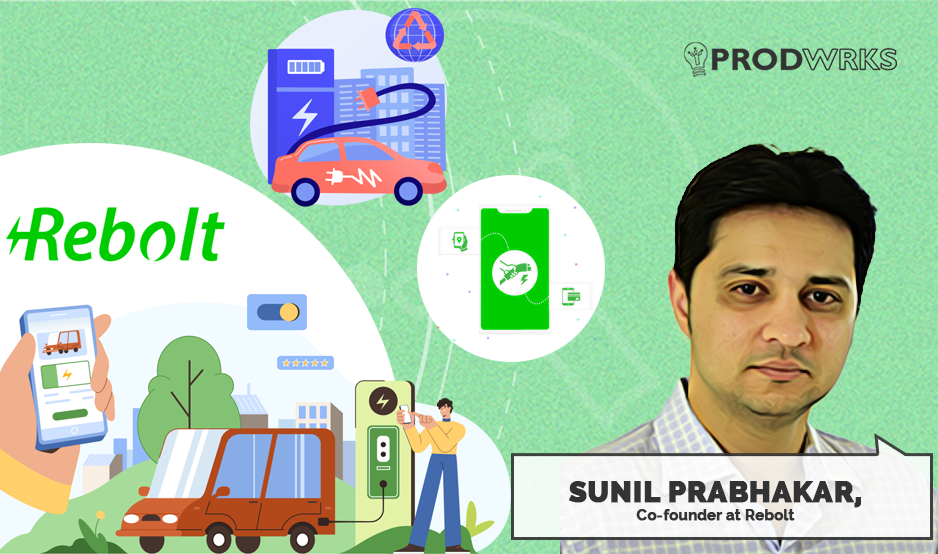
Electric vehicle sales in India have been on a sharp upward trajectory, surging from 95,198 units in 2017-18 to 1,670,736 units in 2023-24, representing a compound annual growth rate (CAGR) of 61% according to a case study by the India Brand Equity Foundation (IBEF). Despite rapid adoption, inadequate charging infrastructure continues to pose a significant challenge.
This surge in EV numbers and lack of charging infrastructure did not go unnoticed by Sunil Prabhakar, a 3x founder with a knack for spotting market gaps before they become mainstream conversations. His observations led him to co-found Rebolt in 2022.
This Bangalore-based startup, cofounded by Sunil, Murali Shankar, and Sudhanva Shetty, focuses on developing a reliable EV charging network tailored for apartment complexes, hotels, and tourist destinations across India.
Over the last two and a half years, Rebolt has installed more than 300 chargers across 140 locations in nearly 50 cities, including 75 apartment complexes in Bangalore and Hyderabad. According to the latest data, the Rebolt charging station app has over 10000+ downloads.
In a conversation with Team ProdWrks, Sunil takes us behind the scenes to show how he is building and scaling Rebolt.
Why Apartment Complexes Trump Public Charging Stations?
“When we started setting up chargers in public places, we realized it wasn’t the right approach for us. Coming from a tech background, we were familiar with the SaaS revenue model, where investing in a setup requires repeated usage to make it worthwhile.”
Sunil identified that such consistent usage was guaranteed in apartment complexes. Compared to highway or other public locations, setting up charging infrastructure in apartments also comes with significantly lower setup costs, as neither power availability nor space generally poses any challenges.
Instead of chasing high-revenue fleet charging, which required heavy capital investment in land and infrastructure, Rebolt placed its bet on passenger EV owners in apartment complexes, as 80% of charging occurred at home.
“It is very easy in this business to burn your fingers. You can spend ₹10 lakhs and set up a charger in a place where nobody will come and charge.”
Tackling EV Charging Challenges in Apartment Complexes
Sunil points out that apartment complexes in tier-one cities often struggle to set up individual EV chargers, largely for two reasons.
The first is a power limitation. Most complexes in India allocate only about 3 kW of electrical load per unit, with premium apartments typically ranging from 5 to 6 kW. A typical EV charger, however, needs 7 kW. This means residents must apply for increased load through complex processes that often discourage individual charger setups.
Sunil says, “You have to go through a lot of hassles, paying extra for the setup, the cost of the charger, installation expenses, and sometimes even bribes. A lot of people just don’t want to go through that. Which is where we decided to come in.”
The second reason came down to safety and infrastructure concerns. When multiple residents try to install individual chargers, each one must draw cables from their main electrical panel to their parking spot. This leads to a tangle of exposed wiring across the parking area, creating a significant safety hazard, which resident welfare associations (RWAs) often oppose.
Large players who often find it easy to set up charging stations in public places find it difficult to get into apartment complexes, as it requires them to engage in fast, on-the-ground negotiation.
Rebolt saw a sweet spot in this space for shared EV charging solutions that they decided to tap into.
“In my 15 years of experience, RWAs are some of the toughest customers to deal with. You’re not talking to a single decision-maker. It's a group of ten volunteers trying to keep a thousand people happy. Unlike setting up highway chargers, which mostly involves dealing with one landowner or authority, apartment setups involve localized approaches that something larger firms are not built for.”
How Rebolt’s Shared Charging Model Works
Rebolt’s hosts shared EV charging stations. They install two types of AC chargers at common points within the apartment premises: a 7 kW charger for four-wheelers and a 3 kW charger for two-wheelers. These standard Level 2 chargers take about five to six hours for a full charge.
Rebolt invests in the hardware and infrastructure itself and operates as a provider of charging infrastructure. Users can gain access to the charger through the Rebolt mobile app. They can start a charging session and pay for the electricity consumed during each charging session.
The host, often an RWA or hotel, sets the base electricity tariff, and Rebolt adds a margin on top, targeting a 25% gross margin on user payments.
“So we don’t cater to individual owners in an apartment complex. Instead, we look at common points where we can set up our chargers and invest in that charger ourselves. Every time someone needs to charge their vehicle, they use our app and pay for the electricity they consume during that session.”
He says, “Typically, an EV owner charges about six times a month, roughly once every four or five days. Over time, this builds a steady, captive base of users who return to our app regularly to charge their vehicles. The additional modules and value-added services we are planning will help with the product’s stickiness. That said, these are not in place today. For now, everything revolves around charging.”
Rebolt is also tapping into “destination charging” by installing chargers in hotels and holiday destinations. This move was a result of observing patterns among apartment users. These customers often travelled to weekend getaways, and Rebolt decided to step in.
Installing chargers in hotels and holiday destinations meant EV owners could rely on the same app and equipment they used at home, which brought with it familiarity and a reliable charging experience even while travelling.
For these users, Rebolt has built an impactful differentiator for resorts and destinations where outages are frequent. An auto-restart feature that brings chargers back online after power cuts without user intervention, where Rebolt’s system detects when power returns and resumes charging automatically.
He says, “It was more about learning on the job. Given the nature of this industry and the pace at which it is progressing and evolving, we have to be ready to adapt as the industry changes. I think we’ve been able to do that, slowly shaping our model along the way. We’ve done a decent job so far, and that’s what has brought us to where we are today.”
Building Trust Through Direct Sales and Word of Mouth
In the early stages, Rebolt relied entirely on direct, on-the-ground sales rather than marketing. Because the target audience was RWAs that were niche, traditional marketing was effective. A dedicated street sales team generated its leads, knocking on doors and pitching directly to resident association members, the key decision-makers in apartment complexes.
Rebolt then focused on building a portfolio of early wins. Once a few apartments came on board, the ability to showcase installations in other well-known complexes created social proof. Resident associations were often connected to each other, and adoption began to spread organically through word of mouth.
“We wanted to be synonymous with apartment charging, so if someone wanted to set up a charger in an apartment, we wanted them to think of us first. Over time, as we built up enough installations to showcase, we began generating leads organically.”
More recently, Rebolt, to accelerate growth during what they see as a critical market window, has added partnerships with platforms like NoBroker and MyGate, to capture as many apartment complexes as possible.These partnerships support targeted marketing efforts while still relying heavily on the word-of-mouth momentum built over the years.
Rebolt currently operates in around 140 locations, including 75 apartment complexes, about 60 resorts and hotels across South India, as well as a presence in sports complexes, malls, and other venues.
The Real Moat: Trusted Networks and Proprietary Systems
At its core, Rebolt’s business is a traditional, execution-heavy operation installing physical chargers, even though it comes with modern IoT and app integrations. Sunil points out that the real moat isn’t in proprietary tech but in building a dense, trusted network over time, which competitors can’t replicate overnight.
Rebolt’s installation, servicing, and customer support are all handled by their teams rather than outsourced contractors, and unlike many EV charging companies that license or buy software, Rebolt developed its entire technology stack in-house. It revolves around three core applications:
EV Owner Mobile App – This is the customer-facing app that every EV owner uses to access Rebolt chargers. The chargers are IoT-enabled, with QR codes that users scan to start a session. Charging continues as long as there’s a balance in the in-app wallet.
Host Dashboard – Given to RWAs, hotels, and other property hosts, this dashboard provides real-time visibility into charger usage. Hosts can track sessions, see who has charged, monitor revenue due to them, and access monthly statements and payment records.
Internal ERP System – A custom-built platform that automates Rebolt’s entire backend. It integrates CRM for sales lead management, purchase and inventory modules for operations, maintenance tracking, issue management for customer support, and complete accounting from P&L to balance sheets.
Sunil says, "Tech is a rarity in this industry because many EV charging companies procure their technology from outside. We built our entire software stack in-house from day one, even before installing our first charger. This gives us the ability to fix issues faster and address problems more efficiently."
Rebolt’s User-Friendly Approach to EV Charging
Rebolt’s earliest versions were straightforward clones of existing apps, where many rival platforms had the users go through a clunky process: open a map, find the charger you’ve plugged into, tap it, and only then begin charging.
Rebolt flipped that flow. Each charger in its network carries a visible number and QR code, letting drivers skip the map entirely, just type the number or scan the code, and charging begins instantly.
Sunil says, “It’s a small design tweak, but with big implications for usability, especially in places where GPS zoom is unreliable or finding a pin on a map is frustrating. When you’re outside, it can be hard to spot a charger on the map, so we made it simple: just enter the number on the charger and start charging, no map search needed.”
The app’s design also evolved to accommodate features that were rare in the market, like advanced booking. Drivers can reserve a charger ahead of time, a convenience that required rethinking parts of the UI to make the process seamless.
Rebolt is closely monitoring the battery swapping model for two-wheelers as an emerging charging solution. Unlike traditional plug-in charging, battery swapping allows users to exchange depleted batteries for fully charged ones at dedicated stations, offering convenience and speed.
However, the lack of standardization across two-wheeler batteries limits scalability and widespread adoption. Despite these challenges, Rebolt sees significant revenue potential in this space and is keeping a close eye on developments, planning to explore battery swapping more seriously once industry standards improve.



